
Stork Prints has introduced a new NovaScreen type for textile printing. It features the top end of Stork Prints’ textile screens collection. This screen is an established brand and delivers the best printability and printing definition.
The new NovaScreen combines the benefits of the existing NovaScreen 165 (mesh) and NovaScreen 195 (mesh). NovaScreen 165 is known for its large open area (19%); whereas NovaScreen 195 offers a very high printing resolution. This unique combination allows printers who prefer NovaScreen 165 for the voluminous paste supply purposes, to work with the new high resolution NovaScreen 195-19%.
The new screen offers a number of benefits like the highest printing resolution combined with the highest screen volume, and improved surface printing. NovaScreen 195-19% is therefore a valuable addition to the NovaScreen collection.
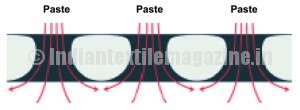
Screen parameters
To fully understand the benefits of the new NovaScreen 195-19%, one must appreciate the general screens’ characteristics, or parameters. The parameters open area, mesh count and screen thickness have a close relation. This is due to the nickel growth occurring during the screen manufacturing process. Simply put, a higher mesh count and a higher thickness of the screen decrease the open area. During the screen making process, the nickel grows from the mandrel in both directions, to the top and to the sides.
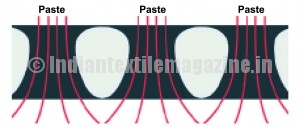
Being an expert in electroforming, Stork Prints is able to steer the nickel growth mainly in the top direction. This way, the dam shape stays thin and gets streamlined. Therefore the ratio between hole-size, mesh count and thickness of the screen can be pushed beyond the conventional boundaries of the rotary screen printing industry.
The existing NovaScreen program illustrates the possibilities in thickness, open area and hole-size:
NovaScreen 135, thickness 120 micron, 22% open area, hole-size 88 micron
NovaScreen 165, thickness 115 micron, 19% open area, hole-size 67 micron
NovaScreen 195, thickness 115 micron, 16% open area, hole-size 52 micron
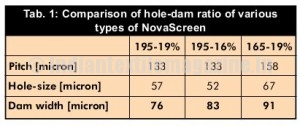
These specifications indicate the boundaries of what was possible in the recent past. However, with the improved production process as described above, it is now possible to expand the open area for a given mesh count even more. The new NovaScreen 195-19% specifications are thickness 115 micron, 19% open area, hole-size 57 micron.
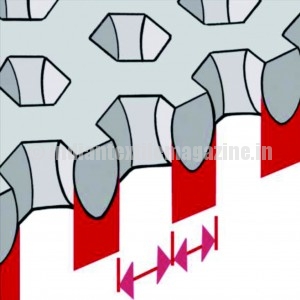
Printability of regular NovaScreen
To fully appreciate the printability of the new NovaScreen 195-19%, we must first look at the printability of regular NovaScreen. Looking at the process of paste transfer from the inside of a screen onto the substrate, we see that the main direction of the paste flow is downwards, straight into the fabric.
Paste flows of neighbouring holes must come together to obtain an even spread of paste on the substrate. In order for this to happen, paste flows need to flow beneath the dams. Logically, smaller and more streamlined dam shapes increase the chance of this to happen, with less squeegee pressure. This permits surface printing as demanded for pigments. This specific design of NovaScreen allows for better control of paste transfer. For example, by applying low shear stress inside the screen, the paste is kept on the textile substrate’s surface.
On the other hand, it is also possible to do penetrative printing, depending on the given print parameters.

Printing with new NovaScreen 195-19%
The current NovaScreen 195 has a 16% open area. Increasing the open area has several technological advantages, such as better paste flow and printability.
The pitch, which is the dimension of one hole and one dam together, stays the same size at a given mesh count. The hole size however gets bigger, resulting in a higher open area while the dam width decreases.
This way, the screen’s printability is substantially improved. Less printing pressure is needed to achieve a decent coverage of the substrate. This is especially interesting for pigment printing, because here the printing takes place at the surface. Avoiding penetration leads to a softer hand and a higher colour yield. Therefore the new NovaScreen can even save paste, and it is more cost-effective in comparison to lower mesh screens.
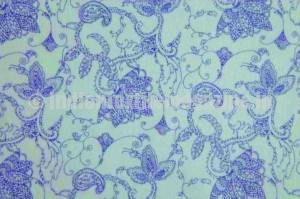
When using NovaScreen 195-19% the most visible and rewarding results are obtained in prints with voluminous substrates and high resolution.
Let’s explore 3 printing techniques: fine-line printing, halftones and reactive printing.
Geometrical and fine-line printing
Geometrical and fine-line printing depend mainly on a screen’s mesh count. The pitch defines the finest line that can theoretically be printed. Any given line will not always be completely straight; in some spots it will be constricted and look more or less curvy/wobbly. The reason for this is that the engraved line is covering spots with more or less holes or bridges.
A screen with a wider hole diameter is therefore contributing to a better line straightness. The open area in an engraved line is higher and allows for better filling of the engraved design. Along with this, the straightness of the printed shapes’ edges is also improved.
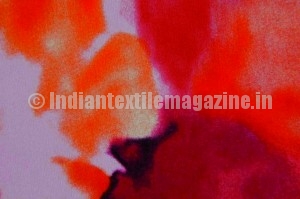
Halftones
Generating halftone impressions in screen printing depends on rasterisation. A shade impression between full tone and no print is achieved by printing a grid structure with dots instead of a continuous print. The human eye mixes the impression of printed and none-printed areas and a halftone impression is produced.
The quality of rasterisation depends on dot definition and on the finest printable dots. The wider hole diameter allows for a better filling of the engraved grid structure and therefore higher definition of the raster dots.
Penetrative printing
In penetrative printing, such as reactive printing, a wider hole-size enables more voluminous paste transfer. This way, the paste can completely penetrate the substrates, which require complete print-through.
Substrates used, for instance, in ladies’ fashion such as knitted viscose or viscose georgette with highly twisted yarn, require a complete saturation by the paste. As the fabric is entirely saturated with paste, superficial unprinted spots which might occur during washing are avoided.
Breezy materials in ladies’ fashion often need a print-through effect – the backside also being covered by printing paste – for optical and design reasons. Really deep and full shades require a high paste volume. Therefore NovaScreen 165 with its high open area is often preferred for those applications.
The new screen features the same open area as NovaScreen 165 and the same definition as the existing NovaScreen 195.
In summary, the new screen type can be seen as a hybrid between the existing NovaScreen 165-19% and NovaScreen 195-16%. It features the advantages of both screen types and can therefore be used for full penetrative printing as well as surface printing, both providing the best possible printing resolution in textile printing.
Stork Prints is a leading global company in the textile and graphics printing market, providing total system solutions: from screens, lacquers, inks and digital engraving to a broad range of rotary screen and digital printing systems. Being an expert in electroforming this not only entails highly reliable rotary screen technology but also an extensive program of precision metal products.